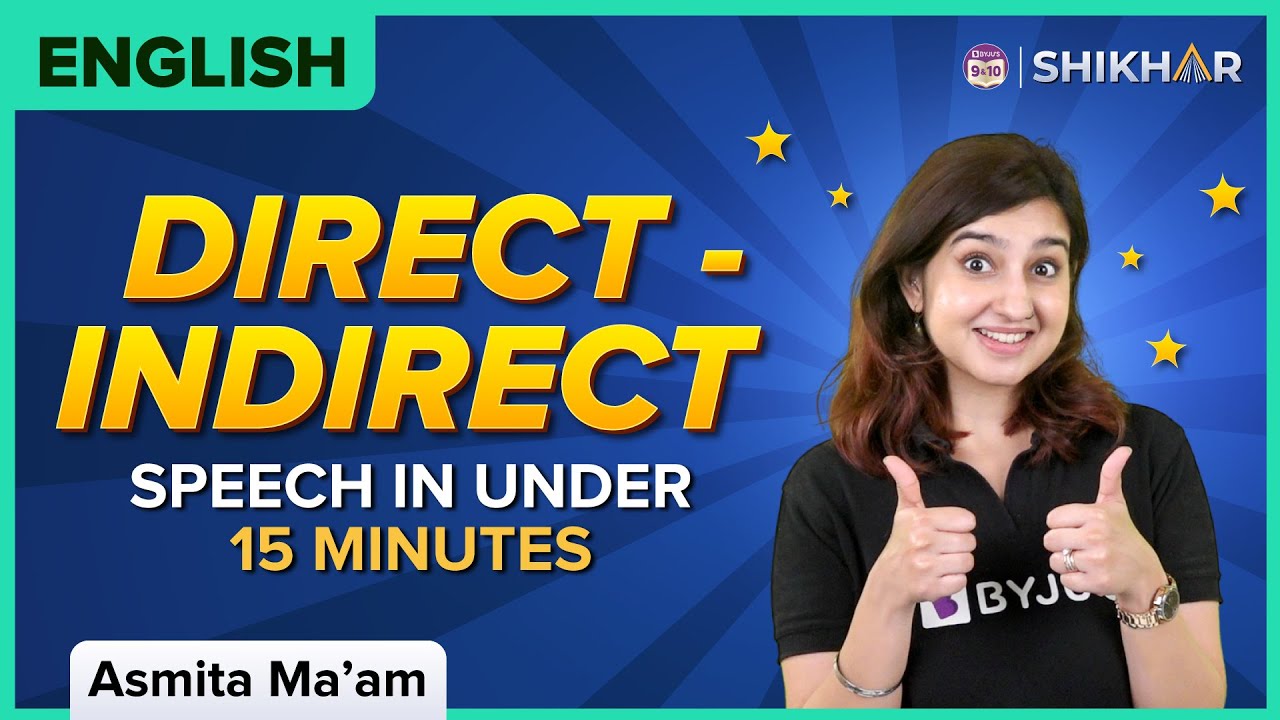Direct and Indirect speech in English - belajar merubah kalimat langsung menjadi tidak langsung
Summary
TLDRIn this educational video, Nanda explains the concept of direct and indirect speech in English. The lesson covers how to convert direct quotes into reported speech, with changes in tenses, pronouns, and time expressions. Using a blend of English and Indonesian, the video provides clear examples, such as shifting from present simple to past simple, present continuous to past continuous, and more. Viewers are guided on how to effectively report speech in both formal and informal settings, with helpful tips and interactive engagement. The video concludes with a reminder to like, comment, and subscribe for more lessons.
Takeaways
- 😀 Direct Speech reports someone's exact words, using quotation marks and no changes to the original words.
- 😀 Indirect Speech reports what someone said, but the words are altered to fit the context, including tense changes.
- 😀 Direct Speech is typically used for reporting current conversations or real-time speech, such as in phone calls.
- 😀 Indirect Speech usually involves changing verb tenses, pronouns, and time expressions to reflect a shift from direct speech.
- 😀 In Direct Speech, you use quotation marks around the exact words spoken, e.g., 'I am studying English now.'
- 😀 When transforming Direct Speech into Indirect Speech, the verb tense often changes (e.g., Present Simple to Past Simple).
- 😀 The Present Continuous tense in Direct Speech changes to Past Continuous in Indirect Speech (e.g., 'I am studying' becomes 'I was studying').
- 😀 Indirect Speech often uses reporting verbs like 'said' and 'told,' and may include 'that' to introduce the reported speech.
- 😀 Time expressions in Direct Speech change when converting to Indirect Speech, e.g., 'today' becomes 'that day,' 'yesterday' becomes 'the day before.'
- 😀 In Indirect Speech, no commas are used, and the sentence structure differs from Direct Speech (e.g., 'She said that she studied English').
Q & A
What is the main topic of the video?
-The main topic of the video is teaching English grammar, specifically focusing on Direct and Indirect Speech.
What is Direct Speech in English grammar?
-Direct Speech is when we quote someone's exact words, and the words are enclosed in quotation marks without any changes.
Can you give an example of Direct Speech?
-An example of Direct Speech is: 'I am studying English now.'
How is Indirect Speech different from Direct Speech?
-Indirect Speech involves reporting what someone said without quoting them exactly. The speech is often introduced with the word 'that' and changes in tense, pronouns, and time expressions.
How does the tense change when converting Present Simple in Direct Speech to Indirect Speech?
-When converting Present Simple in Direct Speech to Indirect Speech, the tense changes to Past Simple. For example, 'I study English every day' becomes 'He/She said that he/she studied English every day.'
What tense change happens when converting Present Continuous to Indirect Speech?
-Present Continuous in Direct Speech changes to Past Continuous in Indirect Speech. For example, 'I am studying English now' becomes 'He/She said that he/she was studying English then.'
What is the rule for converting Present Perfect in Direct Speech to Indirect Speech?
-Present Perfect in Direct Speech changes to Past Perfect in Indirect Speech. For example, 'I have studied English' becomes 'He/She said that he/she had studied English.'
How is the sentence 'I studied English yesterday' transformed in Indirect Speech?
-The sentence 'I studied English yesterday' in Direct Speech changes to 'He/She said that he/she had studied English the day before.'
What happens to the Future Simple tense when changing it from Direct Speech to Indirect Speech?
-Future Simple in Direct Speech changes to Future in the Past in Indirect Speech. For example, 'I will study English tomorrow' becomes 'He/She said that he/she would study English the following day.'
What are some key changes to remember when converting Direct Speech to Indirect Speech?
-Key changes include: modifying the tense (e.g., Present Simple to Past Simple), changing pronouns (e.g., 'I' to 'he/she'), adjusting time expressions (e.g., 'today' to 'that day'), and omitting quotation marks.
Outlines

هذا القسم متوفر فقط للمشتركين. يرجى الترقية للوصول إلى هذه الميزة.
قم بالترقية الآنMindmap

هذا القسم متوفر فقط للمشتركين. يرجى الترقية للوصول إلى هذه الميزة.
قم بالترقية الآنKeywords

هذا القسم متوفر فقط للمشتركين. يرجى الترقية للوصول إلى هذه الميزة.
قم بالترقية الآنHighlights

هذا القسم متوفر فقط للمشتركين. يرجى الترقية للوصول إلى هذه الميزة.
قم بالترقية الآنTranscripts

هذا القسم متوفر فقط للمشتركين. يرجى الترقية للوصول إلى هذه الميزة.
قم بالترقية الآنتصفح المزيد من مقاطع الفيديو ذات الصلة

Direct - Indirect (Reported) Speech in Under 15 Minutes | Class 9 and 10 | English | BYJU'S

BELAJAR DIRECT AND INDIRECT SPEECH (REPORTED SPEECH)

Learn English Grammar: DIRECT & INDIRECT SPEECH (REPORTED SPEECH)

BAHASA INGGRIS SMA - Reported Speech (Indirect & Direct Speech) | GIA Academy

Direct- Indirect Speech; Video Pembelajaran B.Inggris SMA

6º ano - Língua Portuguesa – Vol 2 – Discurso direto e indireto
5.0 / 5 (0 votes)
